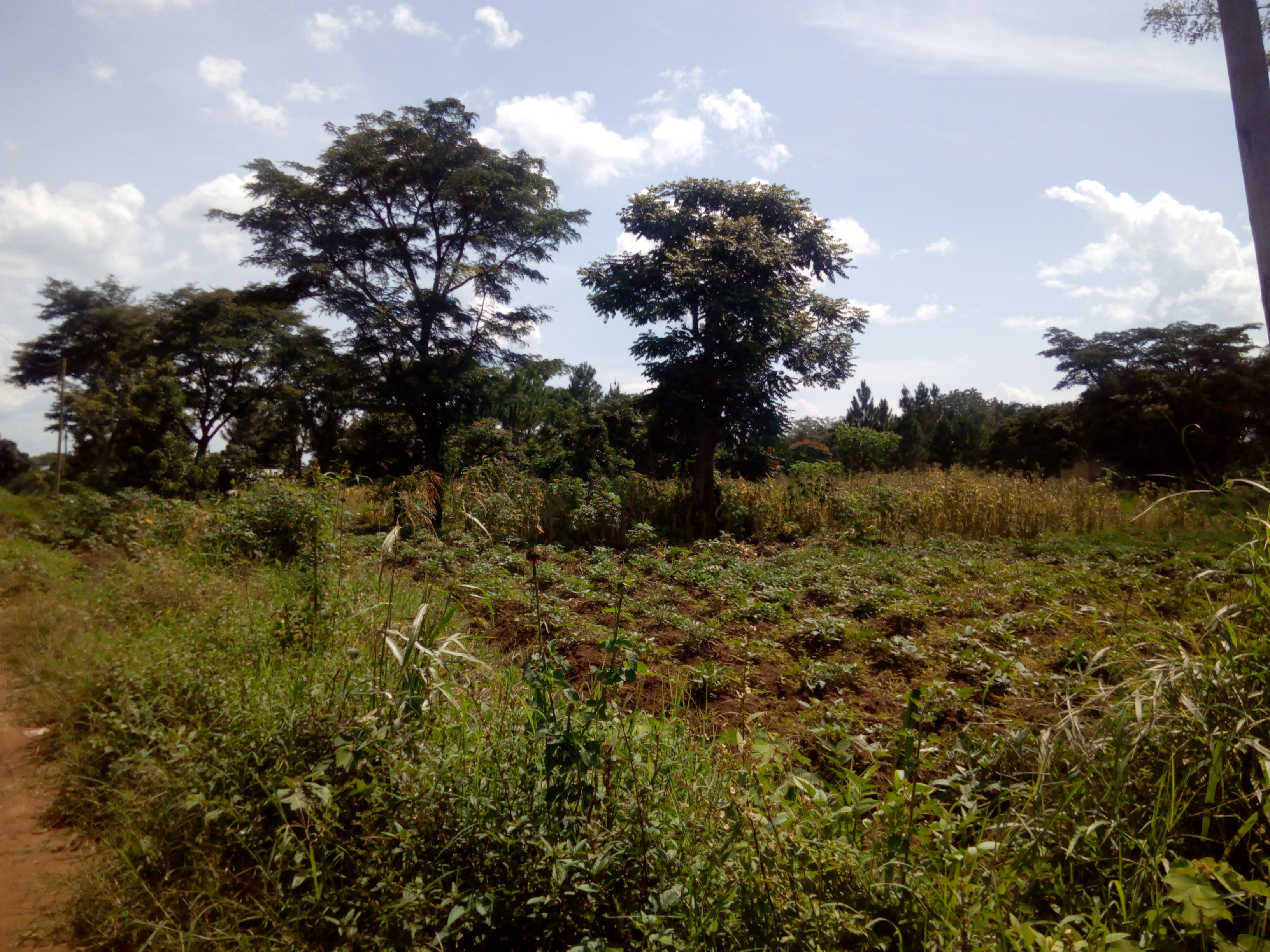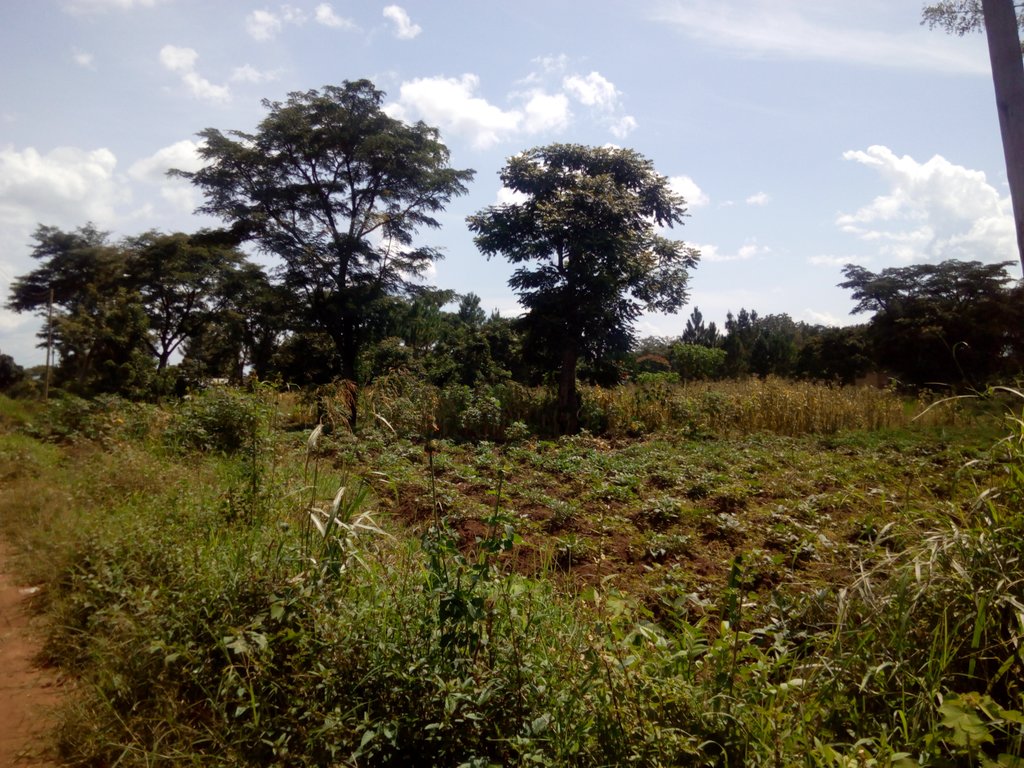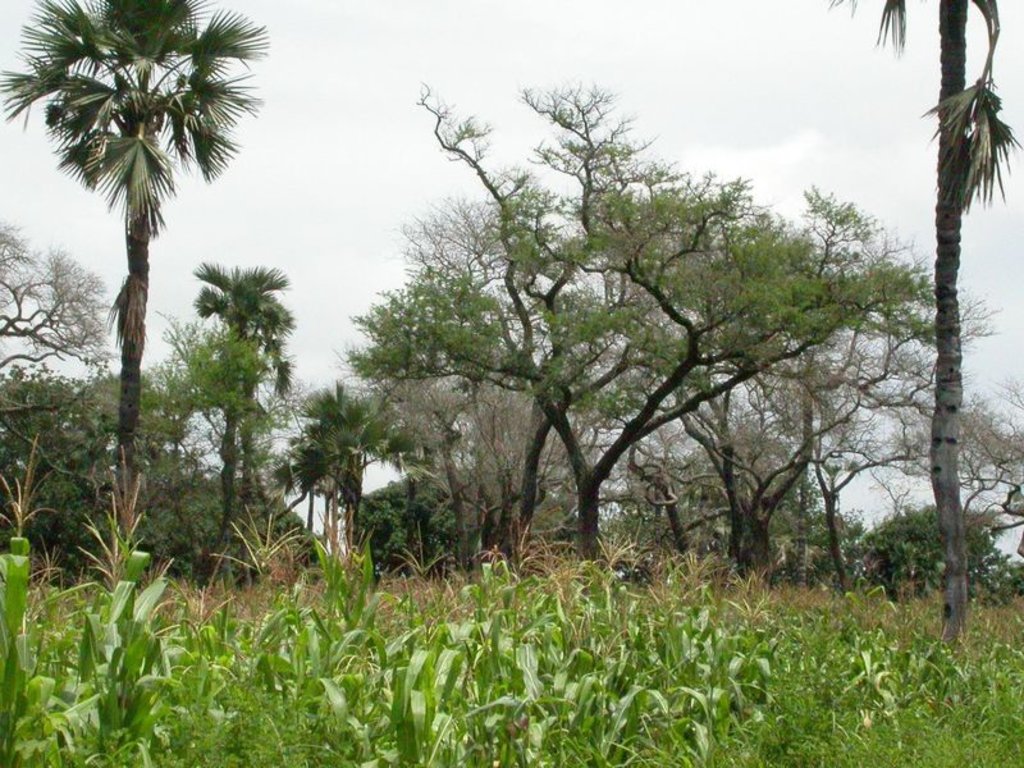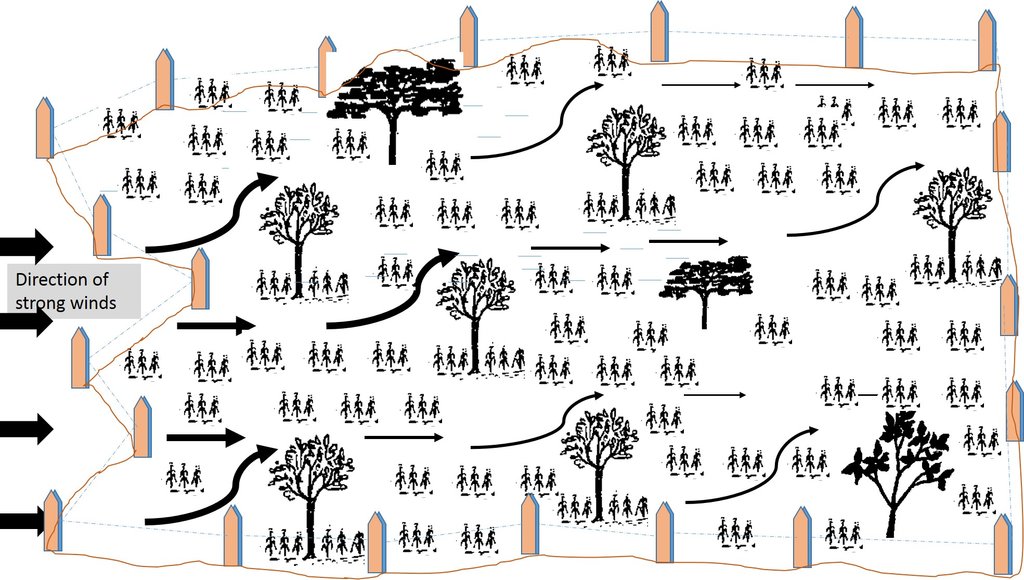Native trees as wind breaks [乌干达]
- 创建:
- 更新:
- 编制者: Bernard Fungo
- 编辑者: JOY TUKAHIRWA, Kamugisha Rick Nelson, betty adoch, Sunday Balla Amale
- 审查者: Nicole Harari, Renate Fleiner
Gwokoyen Ma tye ki Kony
technologies_2871 - 乌干达
查看章节
全部展开 全部收起1. 一般信息
1.2 参与该技术评估和文件编制的资源人员和机构的联系方式
关键资源人
土地使用者:
Otim Richard
+256783771012
Toke Village
Toke Village, Golo Parish, Latanya sub county Pader district
乌干达
有助于对技术进行记录/评估的项目名称(如相关)
Scaling-up SLM practices by smallholder farmers (IFAD)有助于对技术进行记录/评估的机构名称(如相关)
Uganda Landcare Network (ULN) - 乌干达1.3 关于使用通过WOCAT记录的数据的条件
(现场)数据是什么时候汇编的?:
9/5/2017
编制者和关键资源人员接受有关使用通过WOCAT记录数据的条件。:
是
1.4 所述技术的可持续性声明
这里所描述的技术在土地退化方面是否存在问题,导致无法被认为是一种可持续的土地管理技术?:
否
2. SLM技术的说明
2.1 技术简介
技术定义:
Native tree scattered in the garden reduce wind speeds and lower chances of winds damaging crops
2.2 技术的详细说明
说明:
In relatively flat areas such as those in semi-arid parts of northern Uganda, strong winds can exacerbate damage to crops and animal structures in addition to increasing evaporation from watering troughs for animals. To reduce the risk of these occurrences, farmers maintain trees interspersed in the croplands or paddocks to intercept the strong winds.
Trees used for this purpose are generally native species because they grow large in diameter (> 60 cm dbh) and develop wide crowns (~20 m diameter). Some of the native tree species for this technology include Shea tree (Vitellaria paradoxa), and Tido (Khaya grandifoliola). The trees are not arranged in any specific pattern since they establish naturally, and are managed to grow and pruned appropriately to better reduce the impact of strong winds. The spacing between trees can range from 10 to 30 meters depending on the size but also on the location of target structures such as homestead and animal structures. By periodically pruning these trees, farmers also get wood for fuel while reducing the risk of injury from branches falling down as they deteriorate with age. The trees also provide shade in homesteads and in grazing lands. Pruning allows younger branches to emerge and ensures the health and longevity of the trees for several decades.
What farmers like about the technology is that the cost of establishment is generally very low as the care and pruning of trees does not require the purchase of any expensive equipment, planting materials are not required, and there is no labour required for planting. The technology does not take so much land since the trees are sparsely scattered in the crop or grazing land or along the boundaries. Also, the trees provide firewood when the branches are pruned. Sometimes farmers locate bee hives in these trees, thereby ensuring income diversification for the household.
Farmers dislike this technology because native tree species take long (15-20 years) to grow to appropriate sizes to effectively reduce the impact of strong winds and they are also in high demand for charcoal production. Furthermore, they can only be retained where they naturally grow, thus not being very effective as wind breaks as would be the case for those trees that are planted in preferred locations in the landscape. It is labour-intensive to prune these generally large trees with complex crowns, especially when they are fully grown. The trees also acts as hosts for birds, which are formidable pests to crops such as sorghum, simsim and maize in the gardens. The roots of trees extend to large areas within the gardens and can potentially reduce the yield of the nearby crops if root-pruning is not done. These trees also provide additional benefits such as shea from Vitellaria paradoxa that are useful as nutritional supplements. Timber from Khaya grandifoliola is highly valuable and earns additional income to the household.
2.3 技术照片
2.4 技术视频
注释、简短说明:
Video on protected valuable natural tree species in Pader District
日期:
9/5/2017
位置:
Pader District
摄影师的名字:
Issa Aliga
2.5 已应用该技术的、本评估所涵盖的国家/地区/地点
国家:
乌干达
区域/州/省:
Northern
有关地点的进一步说明:
Latanya s/county Pader District
Map
×2.6 实施日期
注明实施年份:
1950
如果不知道确切的年份,请说明大概的日期:
- 50多年前(传统)
2.7 技术介绍
详细说明该技术是如何引入的:
- 作为传统系统的一部分(> 50 年)
3. SLM技术的分类
3.1 该技术的主要目的
- 减少、预防、恢复土地退化
- 保护生态系统
- 结合其他技术保护流域/下游区域
- 保持/提高生物多样性
- 降低灾害风险
- 适应气候变化/极端天气及其影响
- 减缓气候变化及其影响
3.2 应用该技术的当前土地利用类型

混合(作物/放牧/树木),包括农林
- 农林业
主要产品/服务:
Maize, Simsim, Sorghum, Sweet potatoes
如果由于技术的实施而导致土地用途发生变化,则在技术实施前说明土地利的用途。:
No change
3.3 有关土地利用的更多信息
该技术所应用土地的供水:
- 雨养
每年的生长季节数:
- 2
牲畜密度(如相关):
Grazing is done during the dry season usually immediately after harvesting maize and sorghum
3.4 该技术所属的SLM组
- 农业林学
- 防风林/防护林带
3.5 技术传播
具体说明该技术的分布:
- 均匀地分布在一个区域
如果该技术均匀地分布在一个区域上,请注明覆盖的大致区域。:
- < 0.1 平方千米(10 公顷)
注释:
Typical land size is approximately 5 acres
3.6 包含该技术的可持续土地管理措施

植物措施
- V1:乔木和灌木覆盖层
3.7 该技术强调的主要土地退化类型

其它
注释:
Extreme weather events (winds and direct sunshine on crops)
3.8 防止、减少或恢复土地退化
具体数量名该技术与土地退化有关的目标:
- 防止土地退化
- 适应土地退化
4. 技术规范、实施活动、投入和成本
4.1 该技术的技术图纸
4.2 技术规范/技术图纸说明
Trees randomly scattered within cropland
Spacing of trees ranges from 10 to 30 meters
Size of trees ranges from 10 to > 60 cm diameter and 5 to 30 meters in height
4.3 有关投入和成本计算的一般信息
具体说明成本和投入是如何计算的:
- 每个技术单元
指定单位:
Land management unit
指定体积、长度等(如果相关):
6 acres
其它/国家货币(具体说明):
Uganda Shilings
注明美元与当地货币的汇率(如相关):1美元=:
3500.0
注明雇用劳工的每日平均工资成本:
5000
4.4 技术建立活动
| 活动 | 措施类型 | 时间 | |
|---|---|---|---|
| 1. | Protection | 管理 | Always |
| 2. | Pruning | 管理 | Once a year |
4.5 技术建立所需要的费用和投入
| 对投入进行具体说明 | 单位 | 数量 | 单位成本 | 每项投入的总成本 | 土地使用者承担的成本% | |
|---|---|---|---|---|---|---|
| 劳动力 | Labor | 1 | 40.0 | 2000.0 | 80000.0 | 100.0 |
| 技术建立所需总成本 | 80000.0 | |||||
4.6 维护/经常性活动
| 活动 | 措施类型 | 时间/频率 | |
|---|---|---|---|
| 1. | Pruning | 管理 | Once a year |
4.7 维护/经常性活动所需要的费用和投入(每年)
| 对投入进行具体说明 | 单位 | 数量 | 单位成本 | 每项投入的总成本 | 土地使用者承担的成本% | |
|---|---|---|---|---|---|---|
| 劳动力 | labor | 1 | 40.0 | 2000.0 | 80000.0 | 100.0 |
| 技术维护所需总成本 | 80000.0 | |||||
注释:
The technology does no require any inputs apart from labour for pruning. Occasionally farmers may plant one or a few additional trees to reinforce the barriers.
4.8 影响成本的最重要因素
描述影响成本的最决定性因素:
Pruning height of the trees. Higher and larger trees are more expensive to prune but also provide more firewood to the farmer
5. 自然和人文环境
5.1 气候
年降雨量
- < 250毫米
- 251-500毫米
- 501-750毫米
- 751-1,000毫米
- 1,001-1,500毫米
- 1,501-2,000毫米
- 2,001-3,000毫米
- 3,001-4,000毫米
- > 4,000毫米
注明所考虑的参考气象站名称:
Gulu, Uganda
农业气候带
- 半湿润
5.2 地形
平均坡度:
- 水平(0-2%)
- 缓降(3-5%)
- 平缓(6-10%)
- 滚坡(11-15%)
- 崎岖(16-30%)
- 陡峭(31-60%)
- 非常陡峭(>60%)
地形:
- 高原/平原
- 山脊
- 山坡
- 山地斜坡
- 麓坡
- 谷底
垂直分布带:
- 0-100 m a.s.l.
- 101-500 m a.s.l.
- 501-1,000 m a.s.l.
- 1,001-1,500 m a.s.l.
- 1,501-2,000 m a.s.l.
- 2,001-2,500 m a.s.l.
- 2,501-3,000 m a.s.l.
- 3,001-4,000 m a.s.l.
- > 4,000 m a.s.l.
说明该技术是否专门应用于:
- 不相关
5.3 土壤
平均土层深度:
- 非常浅(0-20厘米)
- 浅(21-50厘米)
- 中等深度(51-80厘米)
- 深(81-120厘米)
- 非常深(> 120厘米)
土壤质地(表土):
- 中粒(壤土、粉土)
土壤质地(地表以下> 20厘米):
- 中粒(壤土、粉土)
表土有机质:
- 中(1-3%)
5.4 水资源可用性和质量
地下水位表:
5-50米
地表水的可用性:
中等
水质(未处理):
仅供农业使用(灌溉)
水的盐度有问题吗?:
否
该区域正在发生洪水吗?:
否
5.5 生物多样性
物种多样性:
- 中等
栖息地多样性:
- 中等
5.6 应用该技术的土地使用者的特征
定栖或游牧:
- 定栖的
生产系统的市场定位:
- 混合(生计/商业
非农收入:
- 收入的10-50%
相对财富水平:
- 平均水平
个人或集体:
- 个人/家庭
机械化水平:
- 手工作业
性别:
- 男人
土地使用者的年龄:
- 青年人
5.7 应用该技术的土地使用者拥有或租用的平均土地面积
- < 0.5 公顷
- 0.5-1 公顷
- 1-2 公顷
- 2-5公顷
- 5-15公顷
- 15-50公顷
- 50-100公顷
- 100-500公顷
- 500-1,000公顷
- 1,000-10,000公顷
- > 10,000公顷
这被认为是小规模、中规模还是大规模的(参照当地实际情况)?:
- 中等规模的
5.8 土地所有权、土地使用权和水使用权
土地所有权:
- 个人,未命名
土地使用权:
- 个人
用水权:
- 个人
5.9 进入服务和基础设施的通道
健康:
- 贫瘠
- 适度的
- 好
教育:
- 贫瘠
- 适度的
- 好
技术援助:
- 贫瘠
- 适度的
- 好
就业(例如非农):
- 贫瘠
- 适度的
- 好
市场:
- 贫瘠
- 适度的
- 好
能源:
- 贫瘠
- 适度的
- 好
道路和交通:
- 贫瘠
- 适度的
- 好
饮用水和卫生设施:
- 贫瘠
- 适度的
- 好
金融服务:
- 贫瘠
- 适度的
- 好
6. 影响和结论性说明
6.1 该技术的现场影响
社会经济效应
生产
木材生产
其它社会经济效应
Time spent looking for firewood
生态影响
减少气候和灾害风险
风速
微气候
6.2 该技术的场外影响已经显现
风力搬运沉积物
6.3 技术对渐变气候以及与气候相关的极端情况/灾害的暴露和敏感性(土地使用者认为的极端情况/灾害)
气候有关的极端情况(灾害)
气候灾害
| 该技术是如何应对的? | |
|---|---|
| 热浪 | 好 |
其他与气候有关的极端情况(灾害)
| 其它(具体说明) | 该技术是如何应对的? |
|---|---|
| Strong winds | 非常好 |
6.4 成本效益分析
技术收益与技术建立成本相比如何(从土地使用者的角度看)?
短期回报:
积极
长期回报:
非常积极
技术收益与技术维护成本/经常性成本相比如何(从土地使用者的角度看)?
短期回报:
积极
长期回报:
非常积极
6.5 技术采用
- 10-50%
在所有采用这项技术的人当中,有多少人是自发地采用该技术,即未获得任何物质奖励/付款?:
- 50-90%
6.6 适应
最近是否对该技术进行了修改以适应不断变化的条件?:
否
6.7 该技术的优点/长处/机会
| 土地使用者眼中的长处/优势/机会 |
|---|
| Also provides fire wood for the household |
| Trees also provide shade for the crops and livestock |
| 编制者或其他关键资源人员认为的长处/优势/机会 |
|---|
| Fire wood can be obtained in addition to the environmental services that the trees provide |
6.8 技术的弱点/缺点/风险及其克服方法
| 土地使用者认为的弱点/缺点/风险 | 如何克服它们? |
|---|---|
| Attracts wild animals e.g. snakes | |
| Only men are able to implement the technology because it is difficult |
| 编制者或其他关键资源人员认为的弱点/缺点/风险 | 如何克服它们? |
|---|---|
| The trees sometimes attract wild animals such as snakes and squirrels. | |
| Protection from wild fire is sometimes required if the trees are close (< 10 meters) |
7. 参考和链接
7.1 信息的方法/来源
- 实地考察、实地调查
1
- 与土地使用者的访谈
1
7.2 参考可用出版物
标题、作者、年份、ISBN:
N/a
7.3 链接到网络上可用的相关信息
标题/说明:
Agroforestry system (intercropping beans/maize) with contour ditches, strips of Napier grass, manure and organic fertilizers. (Kenya)
URL:
https://qcat.wocat.net/en/summary/2755/?as=html
标题/说明:
Dynamic agroforestry systems (Bolivia, Plurinational State of)
URL:
https://qcat.wocat.net/en/summary/514/?as=html
链接和模块
全部展开 全部收起链接
无链接
模块
无模块






